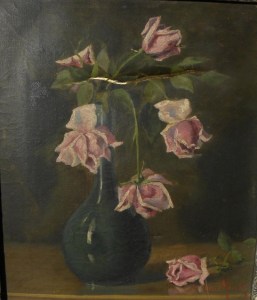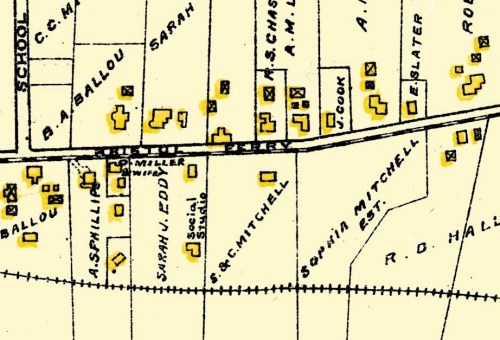
Oscar Miller painting on sale at Ruby Lane website.
Much due to Sarah J. Eddy’s influence, Bristol Ferry was a cultural and intellectual center. It was also a transportation center that made it easy to take the Fall River Line to New York, ferry to Bristol, take a train to Fall River and north or farmers to ship their produce from the freight dock. It was a perfect place for Oscar Miller and other artists to call home.
Oscar Miller was an artist with a national reputation. He created over 1500 works. Miller exhibited at most of the great American art institutions: The National Academy, painting titled “Girl Reading” at the 1904 World’s Fair. He painted marine seascapes, salon paintings, genre studies, and figure studies. Miller had many studios – New York and Paris as well as Portsmouth. His first Portsmouth studio was in the living room of the cottage he built in 1897-8 for his wife to be and then a purpose built 1904 Gambrel or “Dutch” style studio structure with a huge North window on Bristol Ferry Road which still exists today. A shop shed was added when Oscar returned from Europe just before the First World War.
Sarah Eddy liked Oscar’s paintings in a New Your City exhibition and first invited him up to Bristol Ferry in 1896 to “paint the spring.” In Bristol Ferry, Oscar would dress his subjects in costumes – as did Sarah Eddy and other artists of their day. Eddy taught him photography and his photography was just as good as his painting. His grandson, Gus, has glass plates of his grandfather’s photography work.
While in Portsmouth, Sarah Eddy introduced him to the woman who would become his wife – Clara Brownell May – daughter of Floride Mitchel. When their house was finished and furnished in 1898, they married. Clara believed that if she was to marry an artist, it should be one who could put a roof over her head.
Oscar Miller had married into a Bristol Ferry family. Clara’s aunts were part of the Bristol Ferry Art Colony – Sophie Mitchel (artist) and Cora Mitchel (poet and musician). Miller’s home and studio were built on Mitchel land that had been an asparagus farm. The Family raised and traded cotton in Florida. Mrs. Miller’s uncle Colby Mitchel had even been impressed into the Confederate Army and had to be rescued after he contracted malaria and smuggled back North. The family spent their time between Florida and Bristol Ferry.
Oscar Miller was a great organizer with a business mind. His Family had an art gallery on New York’s Fifth Avenue so he would also buy art as well as produce it. He always painted in a spotless suit because much of his work was painting portraits and he never knew when a client might drop by unannounced and he wanted to be able to shake their hand. Miller painted the portraits of many important New York, Providence and Fall River businessmen and matrons.
During the Spring, Summer and Fall, he would make the rounds of European locales – Holland, Northeast France, Brittany, St. Ives in England, Italy, Austria, Switzerland and Belgium. In the winter he would go back to work in his winter studio in Paris to paint works for the great Paris Salon exhibition. Every other year he would return to Bristol Ferry for a few months to visit family and to paint and exhibit locally.
He exhibited at many American and European institutions including: American Federation of Arts, American Water Color Society, Art Club of Philadelphia, Art Institute of Chicago, Le Salon de la Societe des Artistes Français, Memorial Art Gallery Rochester, Milwaukee Art Museum, Museum of Fine Arts Ghent, National Academy of Design, National Arts Club, Newport Art Association, Pennsylvania Academy of Fine Arts, Providence Art Club, Salmagundi Club, and the Society of American Artists in New York. A posthumous retrospective was held at the Rhode Island School of Design.
When he was in Bristol Ferry he loved to go out to paint at dawn or sunset. He thought the light in Bristol Ferry was like that of Holland or Venice because it was surrounded by water that reflected sunlight upward. More than that, Oscar Bristol Ferry among the most beautiful places in the world.
Bristol Ferry was unique. It had the warmest climate on the island and the surrounding water kept the growing fields moist even in drought. People would come to Bristol Ferry farms as a vacation destination. It was a wonderful area for artists to come for the summer season.
Most of my information on Oscar Miller was from an interview with August “Gus” Miller – Oscar Miller’s grandson. Sept. 12, 2014
The image of Oscar Miller’s painting is from this website: https://www.rubylane.com/item/230729-JB04415/OSCAR-MILLER-1867-1921-still-life





 We received this artist box a number of years ago. It had belonged to Claire Fay, a longtime board member of the Portsmouth Historical Society. The paints are relatively new, but the box itself dates from a hundred years ago. A note said it originally belonged to Bristol Ferry Art Colony member Mariette Letourneau – the great aunt of Claire Fay. This item raised some questions. Who was Mariette Letourneau? Was there an “art colony” at the Bristol Ferry neighborhood of Portsmouth.
We received this artist box a number of years ago. It had belonged to Claire Fay, a longtime board member of the Portsmouth Historical Society. The paints are relatively new, but the box itself dates from a hundred years ago. A note said it originally belonged to Bristol Ferry Art Colony member Mariette Letourneau – the great aunt of Claire Fay. This item raised some questions. Who was Mariette Letourneau? Was there an “art colony” at the Bristol Ferry neighborhood of Portsmouth.